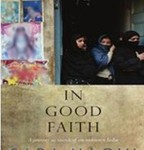In Good Faith”A Journey in Search of an Unknown India

Saba Naqvi
Rainlight/Rupa, New Delhi
2012, 191 pages, Rs. 395
Reviewed by: Yoginder Sikand
Religion as it is lived, does not correspond to the seemingly convenient textbook definitions of it. Such definitions seek to homogenize amazingly diverse forms of religious belief and expression and put them into neatly-definable categories. But this isn’t quite how religion is practiced out there in the ‘real’ world.
Typically, textbooks suggest that the followers of a particular religion share exactly the same beliefs, notwithstanding how seriously they take them in their own lives. Moreover, in conventional ways, each religion is seen as wholly distinct from other religions. Even though they may share things in common, they are treated as if they represent two entirely different cognitive worlds and as having no significant overlaps. Accordingly, their adherents are seen to be having little or nothing in common with each other.
But, as this absorbing book by journalist Saba Naqvi reveals, this is not quite how many Indians understand religion. In the Unknown India she uncovers scores of individuals, communities and historical legends that defy the conventional logic of religions. She terms these as ‘little traditions’, using a phrase discarded since long by the anthropologists, and contrasts them with the ‘orthodox’ versions of religion (for which she uses the equally antiquated term ‘Great traditions’) that are premised on the notion of each religion being a static, homogeneous entity.
Naqvi’s journey across India grew out of her own experience of living with the cross cultural alliances in the immediate family. Her father is a Shia Muslim, and her mother a Christian, the daughter of a woman who later became an ardent evangelist. Naqvi’s former husband is a Bengali Hindu. She grew up jostling with different religious traditions without conforming to any one of them. Being exposed to multiple religions at home, on the one hand, and horrified at the hate, exclusivism and violence promoted in the name of religion, on the other, Naqvi turned”not unsurprisingly”into a ‘non-believer’, as she describes herself. But that did not stop her from celebrating the intermingling of cultures and the overturning and undermining of rigidly-inscribed borders. Even as a ‘non-believer’ she saw the humanistic potential of some religious traditions that, by drawing upon motifs, customs and beliefs from two or more religions defied, in their own silent ways, ‘orthodox’ traditions that had no room for the religious ‘other’.
Naqvi wrote extensively about what she mistakenly terms as ‘syncretistic’ religious traditions communities. While most of the cases are of traditions and communities that illustrate a ‘mix’ of Hinduism and Islam, a few relate to instances of Christian-Hindu interface.
For those who think there’s nothing in common between Hindus and Muslims, Naqvi’s delightful stories will urge rethinking. You’ll encounter ‘low’ caste Bengali Muslim artists painting Hindu deities and travel about singing songs in their praise; a Brahmin priest in Kolkata constructing a mausoleum for a Muslim ‘holy’ man; Maharashtrian Sufis who wrote books on yoga and had Hindu admirers; Banjara tribals in Hyderabad who mourn for Hussain in Muharram; the Muslim female consort of a Hindu god in a Tamil Nadu temple; ‘low’ caste Muslim singers in the Thar desert singing devotional hymns to Hindu deities; Muslims in Haryana who claim to be descendants of Arjuna; the Muslim custodian of a Hindu temple in Ayodhya; Hindu devotees at dargahs in Lucknow and Aligarh; a Muslim who sings paeans to a Hindu Rajput woman at a sati shrine in Rajasthan; Sufis who defied the mullahs and claimed that all religions are paths to a single destination; an Assamase Muslim ‘saint’ whose universal vision of religion had equal room for Hindus and Muslims. And so on.
By highlighting examples that challenge our conventional understandings of religious identities, this book adds much-needed nuance to debates about a subject that inevitably provokes our most deeply-rooted emotions. If vast numbers of Hindus and Muslims in the ‘unknown India’ can live with such camaraderie, why can’t the rest of us do the same, Naqvi seems to ask.
But good intentions alone don’t always suffice. The religious traditions and notions of religious identity are far from being static, immune to pressure from ‘orthodox’ quarters. As she herself admits, many such ‘liminal’ traditions and communities are now veering round to more ‘orthodox’ Islam or Hinduism, whose proponents regard these as deviant. As Naqvi herself acknowledges, shrines that attract devotees from different faith traditions need not necessarily be what we, in our urge to romanticize a putative lost past, might want to see them as. They can be centres of crass superstition, as well as simply a means for crafty priests to make a lucrative living off the credulous. Vast numbers of people flock to such shrines (some of which have been built in the name of entirely fictitious ‘holy’ folks, who never even existed!). There’s absolutely no reason at all to get excited about these centres of belief in the absurd. Just because they bring otherwise squabbling Hindus and Muslims together in common superstition is, surely, no reason whatsoever to celebrate them.
In some cases ‘syncretism’ can simply be a clever missionary strategy and may not be outcome of harmonious synthesis of different faiths. In such cases Missionaries craftily appropriated local motifs, beliefs and customs to enhance prospects for conversion of the gullible. At the same time, however, some of the forms of ‘syncretism’ definitely reflect a genuine urge to evolve a humane understanding of spirituality that transcends narrow boundaries of religion, caste and community.
The book is definitely worth a read, especially if you are looking for inspiring ways to relate to people who don’t think and believe exactly as you do.

COMMENTS